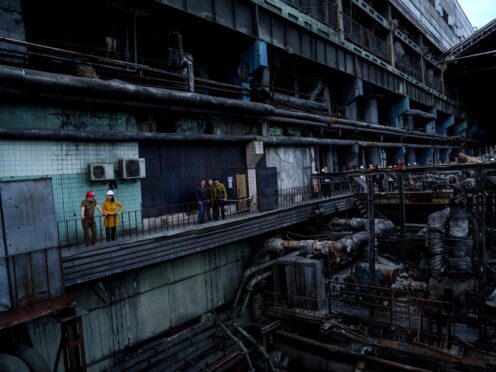
Sustained Russian attacks on Ukraine’s power grid in recent weeks have forced leaders of the war-ravaged country to institute nationwide rolling blackouts.
Without adequate air defences to counter assaults and allow for repairs, though, the shortages could still worsen as need spikes in late summer and the bitter-cold winter.
The Russian airstrikes targeting the grid since March have meant blackouts have even returned to the capital, Kyiv, which hadn’t experienced them since the first year of the war.
Among the strikes were an April barrage that damaged Kyiv’s largest thermal power plant and a massive attack on May 8 that targeted power generation and transmission facilities in several regions.
In all, half of Ukraine’s energy system was damaged, foreign minister Dmytro Kuleba said.
Entire apartment blocks in the capital went dark.
The city’s military administration said at least 10% of consumers were disconnected.
For many, it is a taste of what might be in store if Ukraine doesn’t find other electricity sources before winter.
Before dawn on Wednesday, a Russian drone attack on Sumy plunged the northern Ukraine city into darkness.
Some power was restored to the city of around a quarter-million people in the morning as crews rushed to repair the damage, local authorities said.
With no end in sight to the attacks on the power grid and without a way to adequately defend against them, there are no quick fixes to the electricity shortages, energy minister Herman Halushchenko explained.
Ukraine is appealing to Western allies for more air defence systems and spare parts to fix its Soviet-era plants.
The first major test of the grid will come in July and August, when consumption due to summer heat can mirror levels in the sub-freezing winter months, the minister said.
By mid-May, Kyiv’s residents began to feel the consequences of Russia’s attacks.
A cold snap drove up consumption, forcing Ukrenergo, the main transmission system operator, to introduce controlled blackouts throughout the country.
Ukraine can’t generate enough power to cover evening peaks, and the shortage is greater than the country’s ability to import electricity from Poland, Slovakia and Romania.
Ukraine is hoping to acquire parts from long-decommissioned German plants.
Mr Harkavyi said Ukrainian teams recently went to Germany to evaluate the equipment, which was taken offline because it doesn’t meet European Union environmental standards.
It remains to be seen how willing European allies will be to invest in Ukraine’s coal-fuelled energy sector given their own greener goals.

Enjoy the convenience of having The Sunday Post delivered as a digital ePaper straight to your smartphone, tablet or computer.
Subscribe for only £5.49 a month and enjoy all the benefits of the printed paper as a digital replica.
Subscribe